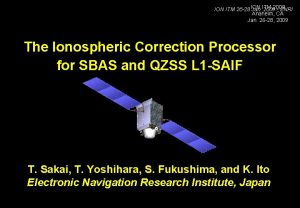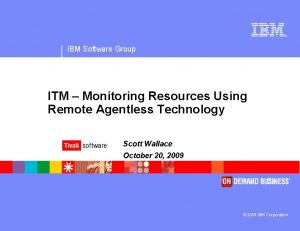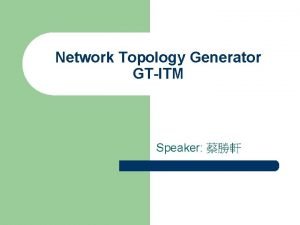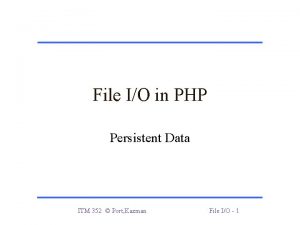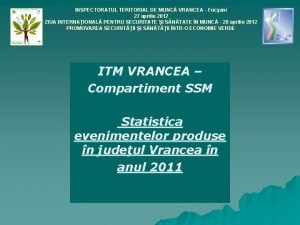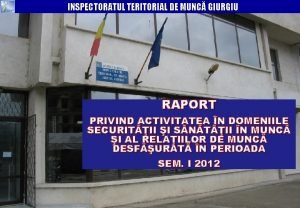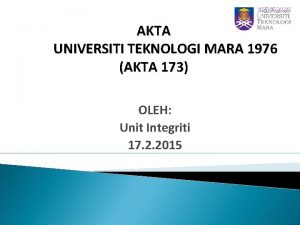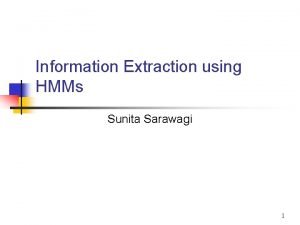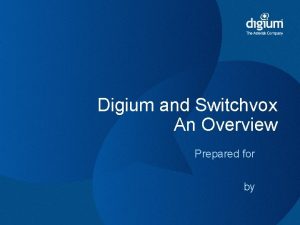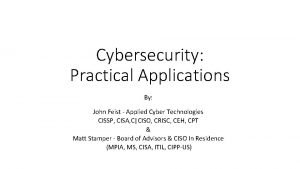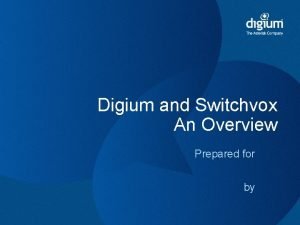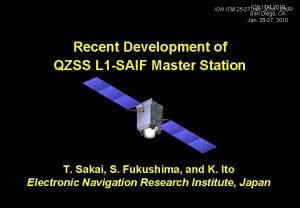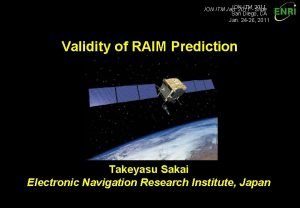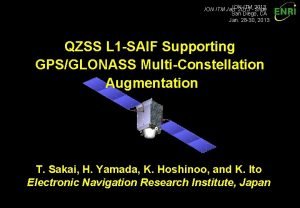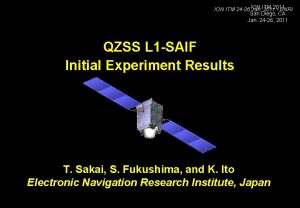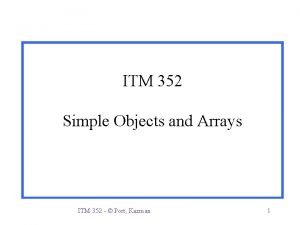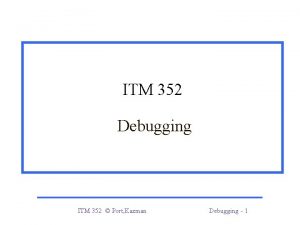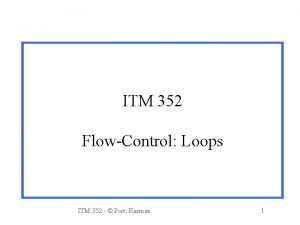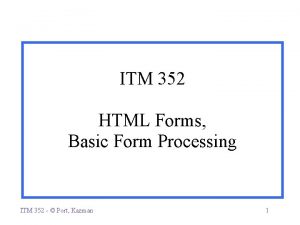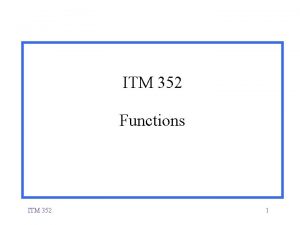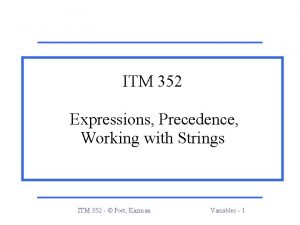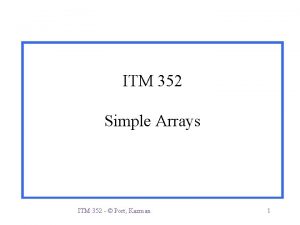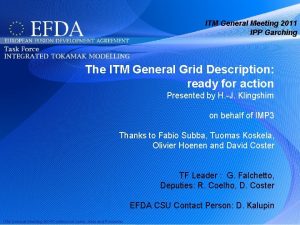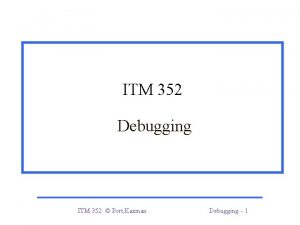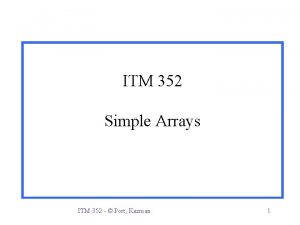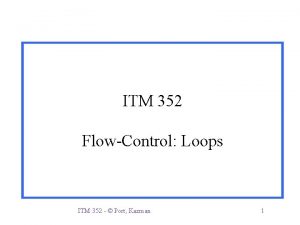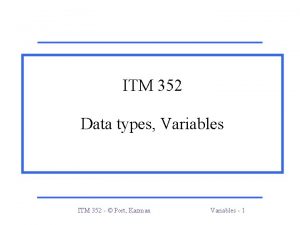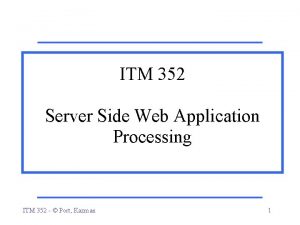ION ITM 2014 San Diego CA Jan 27




























- Slides: 28

ION ITM 2014 San Diego, CA Jan. 27 -29, 2014 Ionospheric Correction at the Southwestern Islands for the QZSS L 1 -SAIF T. Sakai, K. Hoshinoo, and K. Ito Electronic Navigation Research Institute, Japan

ION ITM Jan. 2014 - Slide 1 Introduction • QZSS (Quasi-Zenith Satellite System) program: – Regional navigation service broadcast from high-elevation angle by a combination of three or more satellites on the inclined geosynchronous (quasi-zenith) orbit; – Broadcast GPS-like supplemental signals on three frequencies and two augmentation signals, L 1 -SAIF and LEX. • L 1 -SAIF (Submeter-class Augmentation with Integrity Function) signal offers: – Submeter accuracy wide-area differential correction service; – Integrity function for safety of mobile users; and – Ranging function for improving position availability; all on L 1 single frequency. • ENRI has been developing L 1 -SAIF signal and experimental facility: – L 1 -SAIF signal achieves good accuracy less than 1 meter in an RMS manner at the mainland of Japan; – Ionosphere disturbance sometimes degrades the position accuracy, especially at the Southwestern Islands of Japanese territory; – In order to improve the accuracy at the southwestern islands during ionospheric storm, we have designed some new L 1 -SAIF messages and tested them.

ION ITM Jan. 2014 - Slide 2 QZSS Concept GPS/GEO • • • Footprint of QZSS orbit; Centered at 135 E; Eccentricity 0. 075, Inclination 43 deg. QZS • Broadcast signal from high elevation angle; • Applicable to navigation services for mountain area and urban canyon; • Augmentation signal from the zenith could help users to acquire other GPS satellites at any time.

ION ITM Jan. 2014 - Slide 3 L 1 -SAIF Signal QZS satellites Ranging Function GPS Constellation Error Correction Integrity Function • Three functions by a single signal: ranging, error correction (Target accuracy: 1 m), and integrity; • User receivers can receive both GPS and L 1 -SAIF signals with a single antenna and RF front-end; • Message-oriented information transmission: flexible contents; • See IS-QZSS for detail (Available at JAXA HP). SAIF: Submeter-class Augmentation with Integrity Function Ranging Signal User GPS Receivers

ION ITM Jan. 2014 - Slide 4 L 1 -SAIF Corrections • Example of user position error at Site 940058 (Takayama: near center of monitor station network); • Realtime operation with MSAS-like 6 monitor stations; • Period: 19 -23 Jan. 2008 (5 days); • L 1 -SAIF provides corrections only; No L 1 -SAIF ranging. Horizontal Error Vertical Error Standalone RMS GPS Max 1. 45 m 2. 92 m 6. 02 m 8. 45 m RMS 0. 29 m 0. 39 m Max 1. 56 m 2. 57 m System Standalone GPS Augmented by L 1 -SAIF Augmentation to GPS Only Note: Results shown here were obtained with surveygrade antenna and receiver in open sky condition.

ION ITM Jan. 2014 - Slide 5 Problem: Ionosphere Density (NASA/JPL) • The largest error source: Ionospheric propagation delay; • Varies on the local time, solar activity, earth magnetic field, and so on; • Cannot be predicted; Causes large effect in the low magnetic latitude region.

ION ITM Jan. 2014 - Slide 6 Accuracy at Southwestern Island LT 14: 00 At Southwestern Island (960735 Wadomari) At Northernmost City (950114 Kitami) • During severe ionospheric storm condition (Kp~7+), position accuracy with differential correction largely degrades at the Southwestern Islands; • The effect is not so large at the mainland of Japan; • It is confirmed that increase of the number of GMS shows a little improvement.

ION ITM Jan. 2014 - Slide 7 Actual Ionosphere Corrections PRN 28 PRN 20 5 m At Southwestern Island At Northernmost City • Ionospheric correction continuously differs from the true delay by 5 m or more; • Degradation of position accuracy during storm is due to inaccurate ionospheric correction.

ION ITM Jan. 2014 - Slide 8 L 1 -SAIF Ionospheric Correction 60 Latitude, N 60 • Vertical ionospheric delay information at IGPs ( ) located at 5 -degree grid points will be broadcast to users. 45 • User receiver computes vertical ionospheric delays at IPPs with bilinear interpolation of delays at the surrounding IGPs. 30 • Vertical delay is converted to slant delay by multiplying a factor socalled obliquity factor. 30 15 IGP 0 0 120 150 Longitude, E 180 IPP IGP

ION ITM Jan. 2014 - Slide 9 Thin-Shell Ionosphere Vertical Delay Iv IPP Slant Delay Ionosphere EL F(EL) • Iv Shell Height (350 km) Earth • • • The ionosphere model used by the L 1 -SAIF; Ionospheric propagation delay caused at a single point on the thin shell; The vertical delay is converted into the slant direction via the slant-vertical conversion factor so-called obliquity factor, F(EL).

ION ITM Jan. 2014 - Slide 10 Obliquity Factor, F(EL) Obliquity Factor 6 H=100 km Slant delay Vertical delay 4 H=350 km Elevation Ionosphere Angle Height 2 H=1000 km 0 15 30 Satellite Elevation, deg 45 Obliquity Factor = Slant / Vertical • Slant-vertical conversion factor as a function of the elevation angle; • Also a function of the shell height; The current L 1 -SAIF specifies the shell height of 350 km.

ION ITM Jan. 2014 - Slide 11 Limitation due to Iono-Model Observe here if H=350 km Shell Height H=350 km, EL=25 deg Observe different points if H=600 km Shell Height H=600 km, EL=25 deg • MCS assumes 2 GMS are observing same location of ionosphere; • However, if true height is not 350 km, they are looking at different locations.

ION ITM Jan. 2014 - Slide 12 Limitation due to Iono-Model • Too Simple Vertical Structure: – Assuming the thin-shell ionosphere at the fixed height of 350 km; – IPP location may differ from the actual point with the peak density; Essentially, the ionospheric delay is caused over a certain distance within ionosphere; The model may not represent the horizontal structure as well as vertical. – Obliquity factor may not reflect the true vertical structure of the ionosphere. • Linear Interpolation of Vertical Delays at IGP: – Assumption that the spatial scale of the ionosphere variation is roughly 500 km or more; – Small structure cannot, even if observed, be reflected to the delay information. • Need Alternative Ionospheric Correction Methods: – Change assumptions on the ionosphere or avoid error by some way; – Allow definition of new L 1 -SAIF messages; – Minimize modifications from the current message and correction procedure.

ION ITM Jan. 2014 - Slide 13 Candidate Methods • Maintain Single-Layer Thin-Shell Ionosphere Model: – Employ widely-used simple model to minimize modifications and to avoid complexity of user receivers; – MT 26 -like message structure: Share IGP information given by MT 18; Note: MT 26 has 7 spare (unused) bits. – Define new message as MT 55 (Message Type 55) for this purpose. • Method 1: Variable Ionosphere Height: – Broadcast the peak height of ionosphere in addition to grid delay information. • Method 2: Ionospheric Correction per Satellite: – Generate vertical delay information at the grid points per each GPS satellite. • Method 3: Ionospheric Correction per Direction: – Generate vertical delay information at the grid points per each line-of-sight direction from receiver to satellite.

ION ITM Jan. 2014 - Slide 14 Existing Message Type 26 • MT 26: Broadcast Ionospheric Vertical Delay – Contains vertical delay information at IGP; – A MT 26 message contains information at 15 IGPs; Message Type 26: Ionospheric Delay Information Repeat Content Bits Range Resolution 1 IGP Band ID 4 0 to 10 1 1 IGP Block ID 4 0 to 13 1 15 IGP Vertical Delay 9 0 to 63. 875 m 0. 125 m GIVEI 4 (Table) — 1 IODI 2 0 to 3 1 1 Spare 7 — —

ION ITM Jan. 2014 - Slide 15 New Message Design (1) • Method 1: Variable Ionosphere Height: – Broadcast the peak height of ionosphere in addition to grid delay information; – Both MCS and user receivers need to compute the ionospheric pierce point and the obliquity factor appropriately for given peak height; – MT 55 contains the information of the peak height of the ionosphere. Repeat Content Bits Range Resolution 1 IGP Band ID 4 0 to 10 1 1 IGP Block ID 4 0 to 13 1 15 IGP Vertical Delay 9 0 to 63. 875 m 0. 125 m GIVEI 4 (Table) — 1 IODI 2 0 to 3 1 1 Peak Height 2 (Table) — 1 Spare 5 — — Message Type 55 (1): Advanced Ionospheric Correction Identical to MT 26 Peak Height of Ionosphere 00: 350 km 01: 250 km 10: 600 km 11: 1, 000 km

ION ITM Jan. 2014 - Slide 16 New Message Design (2) • Method 2: Ionospheric Correction per Satellite: – Generate every grid delay information for each ranging source satellite in view; – MT 55 contains an identification of satellite; Satellite ID requires at least 8 bits, however, we have only 7 spare bits in MT 26; Here we use only GPS satellites for the experimental purpose. – May need more measurements (ground stations) for this correction. Repeat Content Bits Range Resolution 1 IGP Band ID 4 0 to 10 1 1 IGP Block ID 4 0 to 13 1 15 IGP Vertical Delay 9 0 to 63. 875 m 0. 125 m GIVEI 4 (Table) — 1 IODI 2 0 to 3 1 1 SV ID 5 1 to 32 1 1 Spare 2 — — Message Type 55 (2): Advanced Ionospheric Correction Identical to MT 26 SV ID (PRN-1)

ION ITM Jan. 2014 - Slide 17 New Message Design (3) • Method 3: Ionospheric Correction per Direction: – Generate every grid delay information for each line-of-sight direction from receiver to satellite (azimuth and elevation angle); – Divide the sky into, for example, 5 directions; Example Definition of LOS Direction 010 101 011 100 MT 55 contains the information of the direction. – Also may need more measurements (ground stations) for this correction. Repeat Content Bits Range Resolution 1 IGP Band ID 4 0 to 10 1 1 IGP Block ID 4 0 to 13 1 15 IGP Vertical Delay 9 0 to 63. 875 m 0. 125 m GIVEI 4 (Table) — 1 IODI 2 0 to 3 1 1 Direction 3 (Table) — 1 Spare 4 — — Message Type 55 (3): Advanced Ionospheric Correction Identical to MT 26 LOS Direction 000: All 001: Zenith 010: North 011: East 100: South 101: West

ION ITM Jan. 2014 - Slide 18 Experiment: Configuration • Experiment Using L 1 -SAIF Master Station (L 1 SMS): – Upgrade to support new messages (MT 55) for Methods (1) to (3); – For this experiment, L 1 SMS operates in off-line mode; No realtime connection to GEONET and QZSS MCS; RINEX files from GEONET; – Evaluate augmentation performance of new messages by receiver software also upgraded to support MT 55. GPS Satellites g in g n Ra GEONET Na v M es sa ge Measurements IF A -S 1 L L 1 SMS al n g Si L 1 -SAIF Message k lin Up nd ba K- Operates in Off-Line Mode al n g Si QZSS MCS GSI Server ENRI JAXA TKSC (Tokyo) (Tsukuba) Evaluation by User Receiver Software

ION ITM Jan. 2014 - Slide 19 Experiment: Configuration • Upgrade of L 1 -SAIF Master Station (L 1 SMS): – Support new messages (MT 55) for Methods (1) to (3); – Accept additional measurements from IMS (Ionosphere Monitor Station) sites to increase the number of measurements (IPPs) for Method (2) and (3); – User receiver software is also upgraded to decode and apply MT 55. GPS Satellites Ra ng in g Si gn al GEONET RINEX Files GMS Data GMS+IMS Data GMS/IMS Measurements Clock/Orbit Corrections Ionosphere Corrections L 1 SMS Upgraded for MT 55 L 1 -SAIF Message Performance Evaluation Receiver Software MT 26/55 User Algorithms User Measurements

ION ITM Jan. 2014 - Slide 20 Experiment: Monitor Stations • Observation Data from GEONET: – GPS network operated by Geospatial Information Authority of Japan; – Survey-grade receivers over 1, 200 stations within Japanese territory. • Monitor Stations for Experiment: – 6 GMS (Ground Monitor Station) near MSAS GMS locations for clock/orbit and ionospheric corrections; – 8 IMS (Ionosphere Monitor Station) for Method (2) and (3) ionospheric corrections. • User Stations: – Selected 5 stations from North to South: (1) to (5) for performance evaluation.

ION ITM Jan. 2014 - Slide 21 Baseline Performance LT 14: 00 At Southwestern Island (User #4) At Northernmost City (User #1) • During severe ionospheric storm condition (Kp~7+), position accuracy with differential correction largely degrades at the Southwestern Islands; • The effect is not so large at the mainland of Japan; • All corrections are derived by measurements from 6 GMS.

ION ITM Jan. 2014 - Slide 22 Variable Ionosphere Height LT 14: 00 At Southwestern Island (User #4) At Northernmost City (User #1) • The ionosphere shell height of 600 km improves position accuracy a little; • However, some degradation is observed at the north and during quiet conditions; The effect is limited; • All corrections are derived by measurements from 6 GMS.

ION ITM Jan. 2014 - Slide 23 Variable Ionosphere Height Storm Condition (11/10/23 to 11/10/26) Quiet Condition (12/7/22 to 12/7/24) • The ionosphere shell height of 600 km may improve the balance of the accuracy between North and South; • The effect is not so large; Need more investigation.

ION ITM Jan. 2014 - Slide 24 Iono-Correction per Satellite LT 14: 00 At Southwestern Island (User #4) At Northernmost City (User #1) • Reduces position error by roughly 40% at the Southwestern Islands, while maintains the accuracy at other regions; • Clock/Orbit corrections by 6 GMS; Ionospheric corrections by 6 GMS + 8 IMS.

ION ITM Jan. 2014 - Slide 25 Iono-Correction per Direction LT 14: 00 At Southwestern Island (User #4) At Northernmost City (User #1) • This method also has a capability to reduce position error at the Southwestern Islands; • Desirable behavior at other regions; • Clock/Orbit corrections by 6 GMS; Ionospheric corrections by 6 GMS + 8 IMS.

ION ITM Jan. 2014 - Slide 26 Iono-Correction per SV/Direction Storm Condition (11/10/23 to 11/10/26) Quiet Condition (12/7/22 to 12/7/24) • These methods have similar performance on ionospheric corrections; • In terms of the number of messages to be broadcast, Method (3) correction per direction has the advantage.

ION ITM Jan. 2014 - Slide 27 Conclusion • ENRI has been developing L 1 -SAIF signal: – Signal design: GPS/SBAS-like L 1 C/A code (PRN 183); – Planned as an augmentation to mobile users. • Ionosphere disturbance is a concern: – L 1 -SAIF signal achieves good accuracy less than 1 meter in an RMS manner at the mainland of Japan; – Ionosphere disturbance sometimes degrades the position accuracy, especially at the Southwestern Islands of Japanese territory; – In order to improve the accuracy at the southwestern islands during ionospheric storm, we have designed some new L 1 -SAIF messages and tested them. Method (3) corrections per direction has a good property. • Further Investigations will include: – Validation of performance against historical storm events at many locations; – Performance at other Asian Countries; – More investigation of other correction methods against ionospheric disturbances.
 Ion itm
Ion itm Ion dipolo
Ion dipolo Dipolos instantaneos
Dipolos instantaneos Phase diagram of carbon dioxide
Phase diagram of carbon dioxide C6h12 fuerza intermolecular
C6h12 fuerza intermolecular Itm monitoring
Itm monitoring Gt-itm
Gt-itm /index2.php?include= si|e: itm
/index2.php?include= si|e: itm Inspectoratul teritorial de muncă
Inspectoratul teritorial de muncă Itm giurgiu contact
Itm giurgiu contact Itm maquillage
Itm maquillage Akta 173
Akta 173 San diego continuing education north city campus
San diego continuing education north city campus San diego housing commission
San diego housing commission Mid coast corridor transit project
Mid coast corridor transit project Sarawagi san diego
Sarawagi san diego Game stop san diego
Game stop san diego San diego sports commission
San diego sports commission San diego department of environmental health
San diego department of environmental health Switchvox san diego
Switchvox san diego Crossdressing san diego
Crossdressing san diego Sd lemsis
Sd lemsis San diego biz law
San diego biz law Aacs san diego
Aacs san diego Cryptlock san diego
Cryptlock san diego Iia san diego
Iia san diego Universal design san diego
Universal design san diego Kaiser san diego family medicine residency
Kaiser san diego family medicine residency Switchvox san diego
Switchvox san diego
